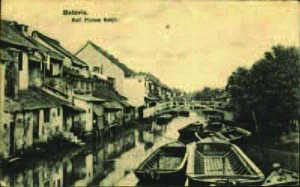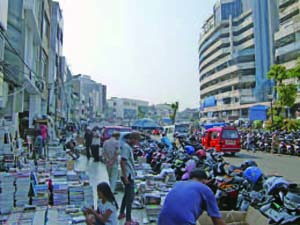Project Leader:IZUMIKAWA, Hiroshi (Hiroshima Jogakuin University, Faculty of Liberal Arts)
Collaborators: MIZUNO, Kousuke (Kyoto University, Center for Southeast Asian Studies)
KITAMURA, Yumi (Kyoto University, Library, Research and Development Laboratory)
UEMURA, Yasuo (Hiroshima University, Graduate School of Letter)
KOZANO, Yakou (Aichi Prefectural University, School of Foreign Studies)
Term:2013-2014
Outline of Research:

Pintoe Ketjil in the colonial period
“Batavia. Kali Pintoe Ketjil”, Digital Image Library, KITLV Universiteit Leiden
(http://media-kitlv.nl/image/6f07fce1-59f4-b6c6-2f8f-8838108ae309)
This research is concerned with the substance of Chinese commercial network in Batavia-Jakarta from 1930s to 1950s. This period was a turning point in Indonesian modern history, and relation between urban development of Jakarta and ethnic network with historian (Dr. Uemura and Mr. Kozano), economist (Dr. Mizuno) and sociologist (Dr. Kitamura). There is a need to focus on the Chinese by researching the urban history of Batavia-Jakarta because since 17th century, they played an important role in Batavia’s urban development.
For this purpose, a workshop to survey the bibliographic sources with other member in Kyoto in 2014 will be organized.
In 2014, based the CSEAS Jakarta liaison office of Kyoto University field work for historical material regarding Batavia-Jakarta will be conducted.
Finally, our team will publish its research results through several workshops and conferences in Japan as well as abroad.
Description:

Pintu Kecil in 2014
H.Izumikawa (photo in September, 2014)
The purpose of research is to analysis the substance of Chinese commercialnetwork from 1930s to 1950s. During this period, destructive changes including Depression, Second World War and Independence War swept across Indonesia.
Previous studies on oversea Chinese have a tendency to emphasize the function of networks based on ethnic business ties. It is said that this type
of network spread beyond national borders, but its limits have not been discussed. As such, there is a need to consider when and to what extent did
this sort of network functioned in competition with other ethnic groups including the Minangkabau or Japanese, especially in 1930s. In other
words, this research is significant in that it reconsiders the effectiveness of ethnic-based networks as an analytical method.
The “outsiders” had an important role in establishing the national economy in the colonial period and nation states in Southeast Asia enabled
their governments to abolish “outsiders” including the Chinese under the name of “nation” after independence. We may be able to consider that
other networks emerged and replaced the Chinese ones. Through an analysis of this historical change we may find clues to understand urban history
from several aspects and characteristic of “crisis and rebirth” from1930s to 1950s.
